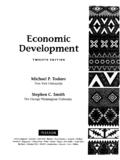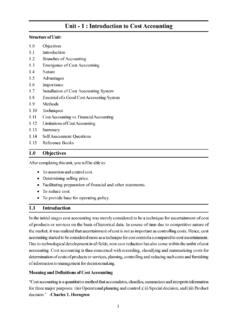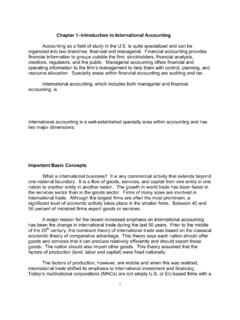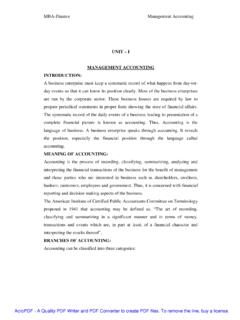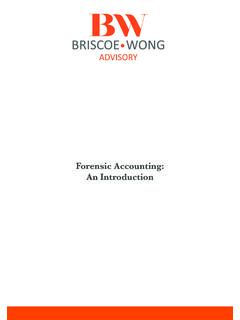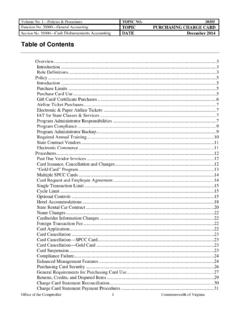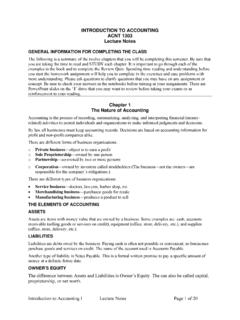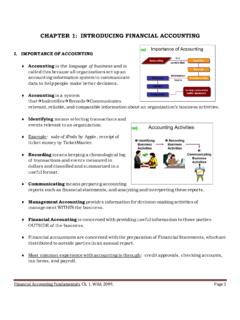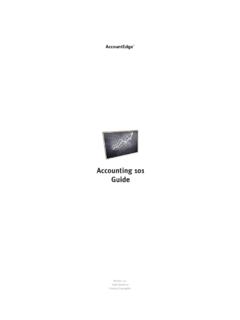Transcription of Accounting and Finance An Introduction Eddie …
1 Accounting and Finance An Introduction Eddie mclaney and Peter Atrill PEARSON Marlow, England London New York Boston San Francisco Toronto Sydney Auckland Singapore Hong Kong Tokyo Seoul Taipei New Delhi Cape Town S o Paulo Mexico City Madrid Amsterdam Munich Paris Milan Contents Preface xxi How to use this book xxii Guided tour of the book xxiv Guided tour of MyAccountingLab xxvi Acknowledqements xxviii Introduction to Accounting 1 Introduction 1 Learning outcomes 1 What are Accounting and Finance ? 2 Who are the users of Accounting Information? 2 The conflicting interests of users 4 How usefui is Accounting Information? 5 Evidence on the usefulness of Accounting 6 Providing a Service 7 Further qualities 8 Weighing up the costs and benefits 8 Accounting as an Information system 11 Management Accounting and financial Accounting 13 Scope of this book 15 The changing face of Accounting 15 Why do I need to know anything about Accounting and Finance ?
2 17 Accounting for business 17 What is the purpose of a business? 18 What kinds of business ownership exist? 19 Sole proprietorship 19 Partnership 20 Limited Company 20 How are businesses organised? 21 How are businesses managed? 25 What is the financial objective of a business? 25 Balancing risk and return 27 Not-for-profit organisations 29 Summary 30 Key terms 32 References 32 Further reading 33 Review questions 34 CONTENTS Part 1 Financial Accounting Measuring and reporting financial position 37 Introduction 37 Learning outcomes 37 The major financial statements - an overview 38 The Statement of financial position 42 Assets 42 Claims 45 The effect of trading transactions 48 Classifying assets 50 Current assets 51 Non-current assets 51 Classifying Claims 53 Current liabilities 53 Non-current liabilities 53 Statement layouts 54 Capturing a moment in time 56 The role of Accounting Conventions 56 Business entity Convention 56 Historie cost Convention 57 Prudence Convention 58 Going concern Convention 58 Dual aspect Convention 59 Money measurement 60 Goodwill and brands 60 Human resources 61 Monetary stability 62 Valuing assets 62 Non-current assets
3 63 Non-current assets with finite lives 63 Non-current assets with indefinite lives 63 Fair values 64 The impairment of non-current assets 65 Inventories 67 Meeting user needs 68 Self-assessment question 69 Summary 69 Key terms 71 Further reading 71 Review questions 72 Exercises 72 Measuring and reporting financial Performance 75 Introduction 75 Learning outcomes 75 CONTENTS The income Statement 76 Different roles 77 Income Statement layout 78 Gross profit 79 Operating profit 79 Profit for the period 79 Further issues 79 Cost of sales 79 Classifying expenses 81 Recognising revenue 83 Long-term contracts 84 Continuous services 85 Recognising expenses 86 When the expense for the period is more than the cash paid during the period 86 When the amount paid during the period is more than the f ll expense for the period 88 Profit, cash and accruals Accounting 90 Depreciation 90 Calculating the depreciation expense 90 Depreciation method 92 Impairment and depreciation 96 Depreciation and asset replacement 97 Depreciation and judgement 97 Costing inventories 99 Inventories - some further issues 103 Trade receivables problems 104 Doubtful debts 106 Uses and usefulness of the income Statement 108 Self-assessment question 108 Summary 109 Key terms 111 Further reading 111 Review questions 112 Exercises 112 Accounting for limited companies (1) 116 Introduction 116 Learning outcomes 116 The main features of limited companies 117 Legal nature 117 Perpetual life 117 Limited liability 119 Legal safeguards 120 Public and private companies 120 Taxation 122 The role of the Stock Exchange 123 CONTENTS Managing a Company 124 Financing limited companies 124 Equity (the owners' claim)
4 124 The basic division 124 Share capital 125 Reserves 127 Bonus shares 129 Share capital jargon 131 Borrowings 132 Raising share capital 133 Withdrawing equity 134 The main financial statements 137 The income Statement 138 The Statement of financial position 138 Dividends 140 Accounting for groups of companies 140 Self-assessment question 144 Summary 145 Key terms 147 Further reading 147 Review questions 148 Exercises 148 Accounting for limited companies (2) 153 Introduction 153 Learning outcomes 153 The framework of annual financial reports 154 The directors' duty to account 155 The need for Accounting rules 155 Sources of Accounting rules 158 The growing authority of the IASB 158 Adopting IFRSs 159 Presenting the financial statements 161 Fair representation 161 Statement of financial position 162 Statement of comprehensive income 163 Statement of changes in equity 165 Statement of cash flows 166 Notes 167 General points 167 The need for a conceptual framework 167 The IASB framework 168 The auditors'role 169 Segmental financial reports 170 Segmental reporting rules 171 Segmental disclosure 172 Segmental reporting problems 173 CONTENTS Creative Accounting 174 Creative Accounting methods 175 Checking for creative Accounting 179 Creative Accounting and economic growth 180 Corporate governance 180 Strengthening the framework of
5 Rules 181 The UK Corporate Governance Code 182 Management commentary 184 Directors' report 185 Strategie report 185 Self-assessment question 188 Summary 189 Key terms 191 Reference 191 Further reading 192 Review questions 193 Exercises 193 Measuring and reporting cash flows 196 Introduction 196 Learning outcomes 196 The Statement of cash flows 197 Why is cash so important? 198 The main features of the Statement of cash flows 200 A definition of cash and cash equivalents 200 The relationship between the main financial statements 201 The layout of the Statement of cash flows 202 Cash flows from operating activities 202 Cash flows from investing activities 203 Cash flows from financing activities 203 Net increase or decrease in cash and cash equivalents 204 The normal direction of cash flows 204 Preparing the Statement of cash flows 206 Deducing net cash flows from operating activities 206 Deducing the other areas of the Statement of cash flows 210 What does the Statement of cash flows teil us?
6 213 Problems with IAS 7 215 Self-assessment question 216 Summary 218 Key terms 219 Reference 219 Further reading 219 Review questions 220 Exercises 220 Anafysing and interpreting financial statements 227 Introduction 227 Learning outcomes 227 CONTENTS Financial ratios 228 Financial ratio classifications 228 The need for comparison 230 Fast periods 230 Similar businesses 231 Planned Performance 231 Calculating the ratios 231 A brief overview 234 Profitability 235 Return on ordinary shareholders' funds (ROSF) 235 Return on capital employed (ROGE) 236 Operating profit margin 238 Gross profit margin 239 Efficiency 242 Average inventories turnover period 242 Average settlement period for trade receivables 243 Average settlement period for trade payables 244 Sales revenue to capital employed ratio 245 Sales revenue per employee 246 Relationship between profitablility and efficiency 247 Liquidity 249 Current ratio 249 Acid test ratio 250 Cash generated from Operations to maturing obligations ratio 251 Financial gearing 252 Gearing ratio 255 Interest cover ratio 255 Investment ratios 257 Dividend payout ratio 257 Dividend yield ratio 258 Earnings per share 259 Cash generated from Operations per share 260 Price/earnings (P/E)
7 Ratio 260 Financial ratios and the problem of overtrading 264 Trend analysis 266 Using ratios to predict financial failure 266 Using Single ratios 267 Using combinations of ratios 268 Z-score models 270 Limitations of ratio analysis 272 Quality of financial statements 272 Inflation 273 The restricted view given by ratios 273 The basis for comparison 274 Ratios relating to the Statement of financial position 274 Self-assessment question 275 Summary 276 CONTENTS Key terms 277 References 278 Further reading 278 Review questions 279 Exercises 279 Part 2 Management Accounting Relevant costs for decision making 289 Introduction 289 Learning outcomes 289 Cost-benefit analysis 290 What is meant by 'cost'? 291 Relevant costs: opportunity and outlay costs 293 Sunk costs and committed costs 298 Non-measurable costs and benefits 299 Using relevant cost as a basis for setting prices 299 Seif-assessment question 300 Summary 301 Key terms 302 Further reading 302 Review questions 303 Exercises 303 Cost-volume-profit analysis 309 Introduction 309 Learning outcomes 309 Cost behaviour 310 Fixed cost 310 Variable cost 312 Semi-fixed (semi-variable) cost 313 Analysing semi-fixed (semi-variable) costs 314 Rinding the break-even point 315 Contribution 321 Contribution margin ratio 321 Margin of safety 322 Achieving a target profit 324 Operating gearing 325 Operating gearing and its effect on profit 326 Profit-volume Charts 327 The economist's view of the break-even Chart 328 Failing to break even 330 Weaknesses of break-even analysis 330 Using contribution to make decisions.
8 Marginal analysis 333 Pricing/assessing opportunities to enter contracts 334 The most efficient use of scarce resources 337 CONTENTS Make-or-buy decisions 339 Closing or continuation decisions 340 Self-assessment question 342 Summary 343 Key terms 344 Further reading 344 Review questions 345 Exercises 345 F ll costing 349 Introduction 349 Learning outcomes 349 Why do managers want to know the f ll cost? 350 What is f ll costing? 351 Single-product businesses 352 Multi-product businesses 353 Direct and indirect cost 353 Job costing 355 F ll (absorption) costing and the behaviour of cost 356 The problem of indirect cost 357 Overheads as Service renderers 357 Job costing: a worked example 358 Selecting a basis for charging overheads 362 Segmenting the overheads 364 Dealing with overheads on a cost centre basis 365 Batch costing 375 Non-manufacturing overheads 375 The forward-looking nature of f ll (absorption) costing 376 Using f ll (absorption) cost Information 378 F ll cost (cost-plus) pricing 380 Price makers and price takers 381 Use of cost-plus Information by price takers 382 Criticisms of f ll (absorption) costing 383 F ll (absorption) costing versus variable costing 384 Which method is better?
9 386 Self-assessment question 387 Summary 388 Key terms 389 Reference 390 Further reading 390 Review questions 391 Exercises 391 Costing and Performance evaluation in a competitive environment 395 Introduction 395 Learning outcomes 395 CONTENTS Cost determination in the changed business environment 396 Costing and pricing: the traditional way 396 Costing and pricing: the new environment 397 Cost management systems 397 The problem of overheads 398 Taking a closer look 398 Activity-based costing 399 Attributing overheads 400 Benefits of ABC 401 ABC versus the traditional approach 401 ABC and Service Industries 401 Criticisms of ABC 406 Other costing approaches in the modern environment 408 Total (or whole) life-cycle costing 408 Total quality management 411 Costing quality procedures 413 Target costing 413 Kaizen costing 415 Value chain analysis 416 Benchmarking 418 Non-financial measures of Performance 420 The balanced scorecard 421 Scorecard Problems 426 Measuring shareholder value 427 The quest for shareholder value 427 How can shareholder value be created?
10 428 The need for new measures 429 Economic value added (EVA ) 430 Self-assessment question 435 Summary 436 Key terms 438 Reference 438 Further reading 438 Review questions 439 Exercises 43g Budgeting 444 Introduction 444 Learning outcomes 444 How budgets link with Strategie plans and objectives 445 Exercising control 446 Time horizon of plans and budgets 44g Limiting factors 449 Budgets and forecasts 44g Periodic and continual budgets 44g How budgets link to one another 450 How budgets help managers 453 The budget-setting process 455 Using budgets in practice 459 Incremental and zero-base budgeting 460 Preparing the cash budget 463 Preparing other budgets 466 Activity-based budgeting 469 Non-financial measures in budgeting 471 Budgets and management behaviour 471 Who needs budgets? 471 Beyond conventional budgeting 473 Long live budgets! 475 Self-assessment question 478 Summary 479 Key terms 480 References 480 Further reading 481 Review questions 482 Exercises 482 Accounting for controf 488 Introduction 488 Learning outcomes 488 Budgeting for control 489 Types of control 490 Variances from budget 492 Riexing the budget 492 Sales volume variance 493 Sales price variance 496 Materials variances 497 Labour variances 499 Fixed overhead variance 499 Reasons for adverse variances 505 Variance analysis in service Industries 506 Non-operating-profit variances 506 Investigating variances 507 Compensating variances 510 Making budgetary control effective 511 Behavioural issues 511 The impact of management style 513 Failing to meet the budget 514 Budgets and Innovation 515 Standard quantities and costs 516 Setting Standards 516 Who sets the Standards?






